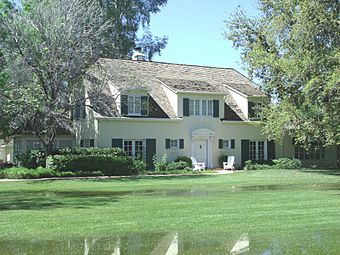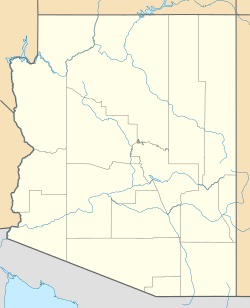E. Payne Palmer House facts for kids
Quick facts for kids |
|
|
E. Payne Palmer House
|
|
 |
|
| Location | Central Avenue, Phoenix, Arizona |
|---|---|
| Built | 1925 |
| Architect | Gordon-Van Tine pre-cut kit house |
| Architectural style | Colonial Revival |
| NRHP reference No. | 02000420 |
| Added to NRHP | 5/2/2002 |
The E. Payne Palmer House is a special kind of home called a kit house. It's a "Brentwood" model from a company called Gordon-Van Tine. This house was built in 1925 on Central Avenue in Phoenix, Arizona.
The "Brentwood" model is designed in the Colonial Revival style. This style was so popular that the house was even shown on the front cover of Gordon-Van Tine's building catalogs in the 1920s. The house is named after a famous doctor from Phoenix, E. Payne Palmer, who owned it later.
Contents
A Look Back: The House's Story
The E. Payne Palmer House, found at 6012 N. Central Avenue, is a great example of the "Revival style" homes built in Phoenix between 1915 and 1940. This area was once part of a larger plan called the Orangewood subdivision. This plan was created in 1895 by a local builder named William J. Murphy.
Murphy wanted to create a peaceful suburb where people could have country-style homes. These homes would still be close enough to the city. The E. Payne Palmer house was put together and finished in 1925. We don't know who the first owner was. However, it's easy to tell it's a Gordon-Van Tine "Brentwood" model. From 1932 to 1939, Leslie Setter lived in the house. Dr. E. Payne Palmer bought the property in 1939.
House Design: Architecture and Style
The E. Payne Palmer House has unique features that show its "Period Revival Style." It also stands out in the southwestern United States. It's a two-story house that looks like the old Cape Cod and Colonial homes from the 1700s.
Outside the House
The house has a rectangular shape. It has a steep, clipped gable roof covered with wood shingles. The roof style is like Cape Cod homes. Other parts of the house show the Colonial Revival style. The front of the house is balanced, with a main entrance in the middle. This entrance has a common pediment (a triangular shape above the door) and wooden columns. These frame the wooden front door.
The walls are covered in stucco with a sandy finish. The windows are made of wood and have many small glass panes. They are placed evenly on the house. On the first floor, there are two large French doors with 10 panes each. There are also two small windows with 4 panes each, next to the main entrance. On the second floor, there are two medium-sized windows with 8 panes each in their own dormers (windows that stick out from the roof). There are also two more pairs of 8-pane windows in a single dormer in the center. The windows have decorative shutters held in place by small S-shaped metal pieces.
There is one chimney that is slightly off-center on the back of the house. The house also has two small rectangular vents on the ends of the roof. A small, one-story part was added to the north side of the house. It has a second-story porch on top. There is also a small enclosed porch on the southwest corner with a small gable roof. The back of the house looks similar to the front, with three dormers and French doors on the first floor. The roof was changed in 1993 from asphalt shingles to wood shingles. The house and its grounds are very well kept by the owners.
Other Buildings and Gardens
The property also has a historic carriage house. This building is similar to the main house. It has stucco walls and a steep gable roof. It was used as living space for house staff. There is also a modern three-car garage and a small, free-standing archway near the front door.
The property is located at an important intersection. This area is known for its fancy estate homes and beautiful tree-lined streets. The house and its location show the artistic value of the North Central Corridor Estates. The house faces Central Avenue, which has a tree-lined section known as the "bridal path." The house and its other buildings sit on almost one and a half acres of gardens. These gardens are at the corner of Bethany Home Road and Central Avenue. The property has a long driveway made of cobblestones and crushed granite. There are gated entrances on Bethany Home Road and Central Avenue, with a concrete block wall around the property.
An old newspaper article from 1949 mentioned the large gardens. They were used for many social events. The back of the house opens onto a big patio and pool area. Some parts of this area, like the brick-edged tree planters and patio deck, might be original to the historic property.
Why This House is Important
The E. Payne Palmer House is important because it shows the special features of "Period Revival architecture." This style was popular in Phoenix between 1915 and 1940. It also represents the growth of large country estates along the North Central Corridor from 1895 to 1942. As a great example of American Colonial Revival architecture, the E. Payne Palmer House is a key part of the successful, garden-city suburb that grew along north Central Avenue.
Kit Houses: Homes from a Catalog
Gordon-Van Tine kit homes were bought from catalogs that came out every year. These catalogs showed pictures of the different house models you could buy. The house featured on the cover was usually the most fancy model. The "Brentwood" was one of these special homes.
A researcher named Dale Wolicki explained how Gordon-Van Tine made these kit houses. The company designed everything to be efficient and reduce waste. They bought wood and hardware in large amounts. Their factories had skilled workers and special machines to cut difficult pieces like roof supports and staircases. The wood was pre-cut to the right length. It was guaranteed to fit and was labeled for easy building.
The kit included many parts: floor supports, sub-flooring, finished flooring, wall studs, roof supports, siding, shingles, stucco, plaster or drywall, columns, railings, doors, windows, hardware, nails, and paint. Plumbing, electrical, and heating systems could be added for an extra cost. Even though the materials were standard, buyers could still make their homes unique. Many models had different floor plans. The outside could be clapboards, shingles, stucco, or ready for brick. Walls, windows, and doors could be moved or changed. Porches, sunrooms, flower boxes, and balconies could also be added.
Dr. E. Payne Palmer: A Community Leader
Dr. E. Payne Palmer was a very important doctor. He helped improve hospitals and medical care in the United States and even around the world. He made big contributions to surgery, cancer research, and patient care in the early 1900s. Dr. Palmer also helped his community in Phoenix. He gave his time and money to religious, arts, and social groups. The house shows Dr. Palmer's success as a doctor and his importance to the community.
Born in 1876 in Mississippi, Errol Payne Palmer became a doctor in 1898. He moved to Phoenix in 1900 and started his first practice. He once wrote that he "rode a bicycle for town calls and rented a horse and buggy from the livery stable for country calls." When Dr. Palmer arrived in Phoenix, St. Joseph's Hospital was very small. It had only twelve beds and no operating room. Doctors would use carpenter saw horses and boards to make an operating table.
In 1902, he successfully removed a large brain tumor. In the same year, he performed a cesarean section. He believed these might have been the first of their kind in Arizona.
During his 50-year career, Dr. Palmer wrote over 65 papers about medicine and surgery. He wrote about cancer and was involved in discussions that led to the creation of the American Cancer Society in 1913. He was one of the first to suggest that cancer could be passed down in families. He also helped pioneer the use of spinal anesthesia. In 1936, he was invited to speak at a big cancer conference in Belgium.
Dr. Palmer was a strong supporter of organized medicine. He was president of several medical groups, including the Arizona State Medical Association. He was also a founding member of the American College of Surgeons. In 1958, he received a special award from them. He was honored for starting the College's program for hospital standardization.
Dr. Palmer and his family lived in the house from 1939 until he passed away in 1960. For over 21 years, the home was a place for many events with Dr. Palmer's professional and social friends.
Images for kids




